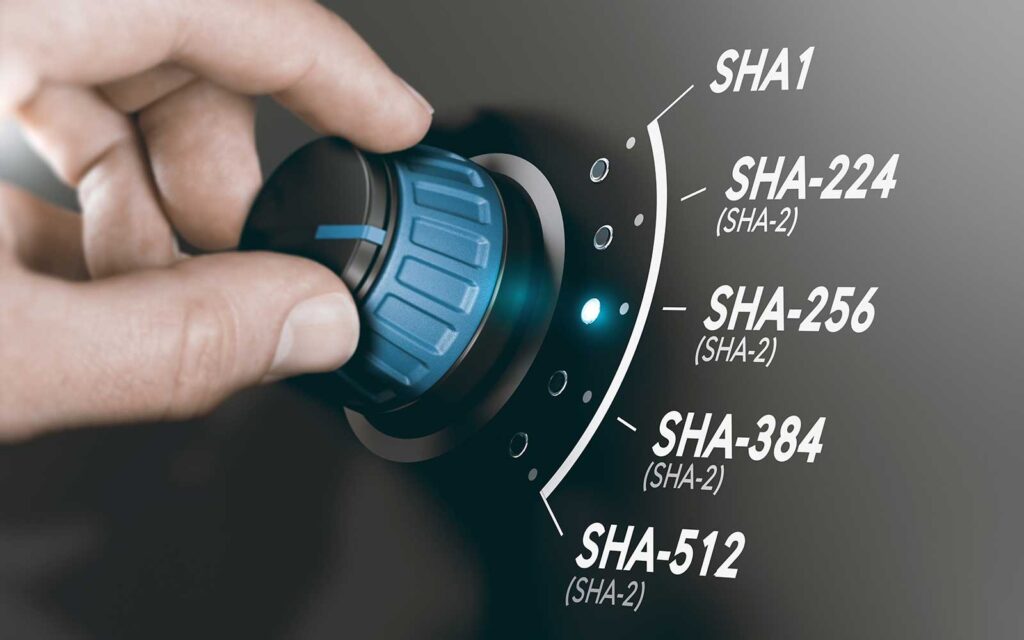In the ever-evolving field of cybersecurity, hashing algorithms play a crucial role in ensuring data integrity and security. Among the myriad of hashing algorithms available, MD5 and SHA-256 are two of the most well-known. Despite their common purpose, these algorithms differ significantly in their design, security features, and applications. This article delves into the differences between MD5 and SHA-256, exploring their unique characteristics, strengths, and weaknesses.
Understanding Hashing Algorithms
Before diving into the specifics of MD5 and SHA-256, it’s essential to understand what a hashing algorithm is and its role in cybersecurity. A hashing algorithm takes an input (or ‘message’) and returns a fixed-size string of bytes, typically a digest that appears random. The output, often referred to as a hash value or hash code, is unique to each unique input. Even a small change in the input will produce a significantly different output.
Hashing algorithms are widely used for various purposes, including:
- Data Integrity: Ensuring that data has not been altered.
- Password Storage: Securing passwords in a way that they can be verified without being stored in plaintext.
- Digital Signatures: Ensuring the authenticity and integrity of a message or document.
MD5: An Overview
MD5 (Message Digest Algorithm 5) was developed by Ronald Rivest in 1991 as an improvement over its predecessor, MD4. MD5 produces a 128-bit hash value (16 bytes) from any given input data. For many years, MD5 was a standard hashing algorithm used for data integrity checks and password hashing.
How MD5 Works
MD5 processes the input data in blocks of 512 bits (64 bytes). The input is padded so that its length is a multiple of 512 bits. The algorithm processes the data in four main stages, involving a series of logical operations, modular additions, and bitwise operations. The final output is a 128-bit hash value, typically represented as a 32-character hexadecimal number.

Strengths and Weaknesses of MD5
Strengths:
- Speed: MD5 is fast and efficient, making it suitable for applications where performance is critical.
- Simplicity: Easy to implement and understand, which contributed to its widespread adoption.
Weaknesses:
- Collision Vulnerabilities: MD5 is susceptible to collision attacks, where two different inputs produce the same hash value. This vulnerability was first highlighted by Hans Dobbertin in 1996 and further exploited by Xiaoyun Wang and Hongbo Yu in 2004.
- Preimage Attacks: MD5 is also vulnerable to preimage attacks, where an attacker can find an input that hashes to a specific output.
- Cryptographic Obsolescence: Due to its vulnerabilities, MD5 is no longer considered secure for cryptographic purposes and has been largely replaced by more robust algorithms.
SHA-256: An Overview
SHA-256 (Secure Hash Algorithm 256-bit) is part of the SHA-2 family of cryptographic hash functions, designed by the National Security Agency (NSA) and published by the National Institute of Standards and Technology (NIST) in 2001. SHA-256 produces a 256-bit hash value (32 bytes) from any given input data.
How SHA-256 Works
SHA-256 processes data in blocks of 512 bits (64 bytes), similar to MD5, but with more complex operations and additional rounds of processing. The algorithm involves multiple stages of bitwise operations, modular additions, and logical functions. The final output is a 256-bit hash value, typically represented as a 64-character hexadecimal number.
Strengths and Weaknesses of SHA-256
Strengths:
- Collision Resistance: SHA-256 is designed to be collision-resistant, making it infeasible to find two different inputs that produce the same hash value.
- Preimage Resistance: It is computationally infeasible to reverse-engineer the input data from the hash value.
- Cryptographic Robustness: SHA-256 is widely regarded as secure and is used in various critical applications, including digital certificates, blockchain technology, and secure password hashing.
Weaknesses:
- Performance: SHA-256 is slower and more computationally intensive compared to MD5, which can be a drawback in performance-critical applications.
Key Differences Between MD5 and SHA-256
- Hash Length:
- MD5: Produces a 128-bit hash value.
- SHA-256: Produces a 256-bit hash value.
- Security:
- MD5: Vulnerable to collision and preimage attacks, making it unsuitable for security-sensitive applications.
- SHA-256: Designed to be secure against collision, preimage, and second preimage attacks, making it suitable for high-security applications.
- Performance:
- MD5: Faster and less computationally intensive.
- SHA-256: Slower but offers significantly better security.
- Use Cases:
- MD5: Legacy systems, non-security-critical checksums.
- SHA-256: Digital signatures, SSL/TLS certificates, blockchain, password hashing, and other security-sensitive applications.
- Adoption:
- MD5: Historically popular but now largely deprecated due to security vulnerabilities.
- SHA-256: Widely adopted as a standard for secure hashing, recommended by NIST and other standards organizations.

Practical Considerations
When choosing between MD5 and SHA-256, it’s crucial to consider the specific requirements of your application:
- For Data Integrity Checks: If the primary concern is to detect accidental data corruption and performance is a critical factor, MD5 might still be used. However, its security vulnerabilities should be carefully considered, and alternatives like CRC32 might be preferable for non-cryptographic uses.
- For Security-Sensitive Applications: SHA-256 is the clear choice due to its robust security features. Whether it’s for securing passwords, digital signatures, or blockchain transactions, SHA-256 provides the necessary cryptographic strength to withstand modern attacks.
MD5 and SHA-256 serve the same fundamental purpose of generating hash values from input data, but they differ significantly in terms of security and performance. MD5, once a widely-used hashing algorithm, has been rendered obsolete by its vulnerabilities to collision and preimage attacks. SHA-256, part of the SHA-2 family, offers enhanced security features that make it suitable for a wide range of critical applications.
As cybersecurity threats continue to evolve, the importance of using secure and reliable hashing algorithms cannot be overstated. While MD5 may still have limited use in non-critical applications, SHA-256 is the recommended choice for any application requiring robust security and data integrity. By understanding the differences between these algorithms, developers and cybersecurity professionals can make informed decisions that enhance the security of their systems and data.

